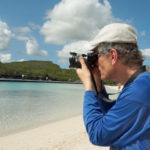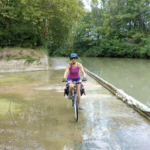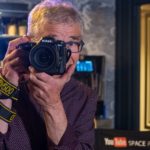Curaçao’s Hato airport is a small informal affair just outside the capital Willemstad, so I quickly spot Joy, my driver. We’re off to Nieuwpoort, about 30 minutes east of Willemstad.
There’s a gate at the entrance, and then it’s another five kilometres to the shore. We drive along a golf course and past a small, gated community of homes on The Spaanse Water, a large bay. This is a secluded location, far from anything else.
Joy tells me that King Willem-Alexander of the Netherlands is also staying at Santa Barbara. It’s Willem-Alexander’s first visit to Curaçao, which is a separate country within the Kingdom of the Netherlands.
It’s late afternoon, and it’s been a long day of travelling, with a stopover in Miami. The staff checks me in, escorts me to my room and invites me to relax and freshen up before I have dinner with John, the director of sales and marketing.
The large and nicely appointed room
The hotel feels like a Spanish Hacienda. The room is large, and elegantly appointed with lots of wood décor and accents. First-class, Five-star – whatever your term for top quality is, this resort deserves the description. I open the shutters to let the sun in, and watch a beautiful sunset over the sandy beach.
John and I have dinner at Medi – the main restaurant on the resort. He describes the menu as “global cuisine based on local sustainable products”. The resort is only three years old. Originally a Hilton, it’s now managed by Benchmark. There are 350 rooms, spread over a large property. The rooms in the west wing all face the beach – the largest on Curaçao. The beach is not actually on the Caribbean, but on one side of an inlet that leads to The Spaanse Water.
The longest beach on Curaçao
John explains that while the beach looks man-made, the only addition the hotel has made is a pier to protect the beach from the occasional boat traffic in and out of the bay. Unlike most Caribbean islands, tourism has not been Curaçao’s focus – the main industry is an oil refinery originally owned by Shell and now by the government, which leases it to the Venezuelan state oil company.
An increased interest in attracting tourists to the island has resulted in Santa Barbara now offering packages through Sunwing, Westjet and Air Canada – all of which offer direct weekly flights – which I would highly recommend over my transit in Miami.
Back in the room, Wi-Fi is excellent; I plug my iPhone into the bedside iHome speaker dock and stream CBC radio for the news from Toronto City Council.
Rebecca, Director of Sales, joins me for breakfast from the extensive buffet and helps plan my itinerary for the next few days. Emmy, Sales Manager for the Caribbean and Latin America, gives me a tour of the property. It’s large, but simply laid out. It seems quiet, with very few guests. Emmy says they’re about 35% full, but even at peak occupancy, it never feels busy. The international clientele is primarily European, and predominately Dutch, and also includes American and Latin American visitors.
The Old Quarry Gold Course
To explore further, I borrow a bike to tour around the 1,500 acres. I pick it up at the tennis courts – which are hydro-clay, a kind of irrigated clay surface suitable for hot climates. I head down the road towards the gate. It’s a bit like biking through a golf course, as the holes are on either side of the road, pretty much all the way back to the gate. The views of the bay and Tafelberg (literally Table Mountain) keep stopping me to take photos. It’s hot and the bike is sluggish, so I’m grateful for a bird watching platform that provides a shady rest stop. It overlooks a small pond and there’s lots of activity, but I’m without binoculars or a major zoom lens.
On the way back, King Willem-Alexander’s motorcade zooms by. I stop and wave.
I enjoy a refreshing beverage and grilled shrimp by the pool, then a gelato from the pizza/gelato bar. Gerald takes me on a golf cart tour of the Pete Dye designed Old Quarry golf course. The holes straddle the road and reach nearly back to the entrance, with great vistas at every tee and green. Although I’m invited to play a round, I decline, as my handicap actually makes it advisable not to play.
I have a quiet dinner at the sushi bar in the lobby. Although the selection is small, the quality is good. I just wish there were dining tables and chairs to sit, in addition to the sofas and lounge chairs.
The next morning at breakfast, I only have to glance at the waiter to have him say “cappuccino”, which appears moments later. Looking out over the grounds, I feel profoundly relaxed. I seriously contemplate staying in this chair, and enjoying a selection of beverages for the remainder of the day. It takes considerable energy to get myself out to the resort’s pier to be picked up by a Bounty Adventures catamaran for a half-day snorkeling trip. We sail away as my fellow adventurers gaze enviously at Santa Barbara.
We stop a couple of times to snorkel – but we stay close to shore where the water is not as clear and the fish and coral not as colourful as I’ve seen elsewhere. Roy, our guide, takes a few of us looking for some interesting creatures and features, but they’re avoiding him today. He recommends the all-day trip to Kleine Curaçao as more interesting. The trip included a barbeque lunch prepared while we swam.
After we return I enjoy a beverage by the pool. As soon as the bartender notices that I’m swatting away some insects, he places a can of repellant on the counter for my use.

Chichi at Serena’s Art Factory
For the afternoon, Rebecca has asked Joy to take me to some local attractions – a natural herb and medicine garden, an aloe plantation and an artist’s studio. Although diverting, they’re not compelling.
While snorkeling I wasn’t thinking about sun exposure on my back – and now I’m starting to feel the effects. A quick trip to the resort’s Atabei spa for the sixty-minute sun recovery wrap provides the needed relief.
For dinner I visit the other restaurant – Shore, which is slightly more stylish. The menu is based on grilled meats and also features other options. The menu is very customizable – you pick your selection of spices, sauces and accompaniments. There are lots of interesting spices, not all of which are hot. I select a local fish with a lime cilantro sauce, pineapple salsa and cucumber salad. The combination yields an interesting taste with a slightly spicy kick. The wine list is extensive, with a good selection of French, Italian, Spanish and South American wines. There’s even an Inniskillen ice wine on the dessert list.
Service here, as at the other restaurants and bars is friendly, helpful and attentive. The staff switches from English to Dutch and back, as I try to exercise my childhood vocabulary, irrationally switching from one to the other and throwing in the few words of Papiamento they’ve been teaching me.
Thursday morning Clarina from the Curaçao tourist board takes me into Willemstad. I ask if they celebrate “Sinterklaas” on December 6th, as they do in Holland. Clarina says they do, but we strike out trying to find some traditional Dutch Sinterklaas treats.
We stop at Landhuis Chobolobo, where Curaçao liquor is made. This is the original, it’s available in multiple colours including blue, but the flavour remains the same. The factory also makes other flavoured liqueurs and a cooling spray.
Interior of the Mikve Israel-Emmanuel Synagogue
Willemstad is the capital of Curaçao, founded in 1634 by the Dutch West India Company. We park near the market and walk through the colourful streets to the Mikve Israel-Emmanual Synagogue, founded in the 1650’s. The current building dates from 1730, and is one of the oldest synagogues in the Americas. In design and décor, it bears a striking resemblance to the Portuguese shul in Amsterdam. The floor is sand, a Sephardic tradition from the Inquisition in Spain, when sand was used to muffle footsteps. Clarina explains that it’s also symbolic of the forty years the Israelites spent in the desert after fleeing from Egypt.
Willemstad’s postcard photo – the colourful shops along the Handelskade. Taken using the NEX6’s autoHDR painting mode.Willemstad’s architecture is reminiscent of Europe, particularly Amsterdam – with the addition of very colourful paint. The likely apocryphal story says that a governor commanded everyone to paint their homes as he claimed his headaches were aggravated by the glare of white buildings. Apparently he also owned the island’s paint factory.
We walk by the floating market. With little indigenous agriculture on the island, Venezuelan vendors come here to sell fruit, fish and vegetables. Then across the floating Queen Emma Bridge, a pontoon bridge that swings open and closed to let boats – cruise ships and oil tankers – in and out of the harbour. If the bridge will be open for a long time, a ferry service takes you across the inlet. From the bridge, I take the famous postcard photo of the colourful shops along the Handelskade.
For lunch we stop at the Marsche Bieuw (old market), a covered area where several vendors have open kitchens and cafeteria tables. The selections seem similar, and some are closed today. Clarina has her favourite, and that’s where we sit. She asks me to pick which meat I like, so I choose goat, and she orders a krioyo (island food) stew with goat for me.
Everyone seems to be drinking regular canned soft drinks, but I have the kitchen’s special “awa di lamunchi”, a refreshing lime lemonade. We chat with the other diners around us – everyone has their favourite dish and is happy to share their opinions and experiences. Everyone’s like an old friend. Between Clarina and myself we’re managing to conduct conversations in Dutch, English, Spanish and Papiamento. The heaped plate is way too much for lunch – but it’s an experience I wouldn’t miss.
In the evening I’ve been planning to go to Blues, as I’ve heard they have a spectacular Jazz jam on Thursday nights. Clarina has been told to take me to Myles, so that’s our first stop. There’s no live music, so we stroll around the Wilhelminaplein where a collection of boulevard cafés gives off an atmosphere that’s decidedly European, and the Waterfort Terrace, another collection of restaurants overlooking the water.
When we get to Blues, we manage to squeeze ourselves into the last two seats. It’s a fairly small restaurant, built on a pier over the water. Around the perimeter there are dining tables with windows facing out surrounding a raised area with bench seating around the bar. We’re on the bench and have a great view of the platform above the bar, which is small and accessed with a ladder. As the musicians climb up, I wonder if the platform can support them all, but they’ve obviously done this before.
The audience listens intently as the quartet meanders through a selection of standards. Their approach is clearly informal, and the rhythms are fluid – as each tune progresses, they become increasingly complex and influenced by Latin and Caribbean beats. The waitress comes around with bitterballen – deep-fried beef and flour hors d’oeuvres (a real Dutch bar snack) – for us to sample.

Chaya Proost at Blues
Chaya Proost, a singer on holiday from Holland, climbs up on the stage and sings “Fallin”, and “Stay Together”. The strength of their improvised collaboration is impressive and the crowd and the band encourage her to stay, so they agree on “Fly Me to the Moon”. We are all having a great time.
John James Willekes
John James Willekes, a Curaçao native with an international reputation, climbs up to join the quartet on sax. I don’t recognize the intricate melodies that he’s playing, and if the looks they’re exchanging are anything to go by – they’re all improvising in and around his riffs. My ears are dancing.
We can’t stay for the last set, but it looks like they’ve lined up some more guests – including a very young guitarist. This has been an evening that has exceeded my expectations.
Willemstad is definitely a must-see – but from Santa Barbara it’s a $40. cab ride either way. Apparently the hotel used to have a shuttle, but no more.
Checking out proves to be as interesting an experience as I’ve anticipated. I’m on an all-inclusive plan, but I’ve been signing chits for meals and adding tips every time I go to a bar or restaurant. On the first attempt, everything is included, so I remind the clerk that I’m on an all-inclusive. The second attempt still includes the Wi-Fi, so she verifies that’s included and removes it. So it goes until the fifth try, when we finally have a bill that we can agree on. But I’m still wondering how the gratuity works – that’s something I would have expected to pay. And although it was explained when I arrived, I did find it odd that the pizza/gelato bar isn’t included.
The last day has arrived too quickly and Joy is waiting to shuttle me back to the airport.
I’ve been looking on Tripadvisor for Willem-Alexander’s review of Santa Barbara, but it hasn’t appeared yet. I’m hoping he enjoyed his island and this resort as much as I did.
Disclaimer: My trip to Curaçao was sponsored by The Curaçao Tourist Board and Santa Barbara Resort, who did not review this post (or the story in The Star) before publication. I’m thankful to them for their hospitality. The Canon SL1 and Sony NEX6 which were used to take the photos were on loan from Sony and Canon.
My story in The Star about the trip




